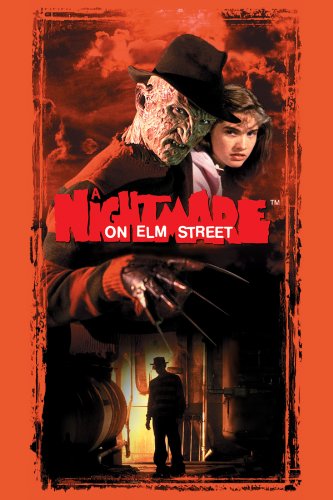 Wes Craven’s horror hit took elements of then-current horror films (numerous teens dying in graphic ways) and refashioned them into an imaginative alternative to the stalk-and-slash formula of FRIDAY THE 13TH, et al. The film combines horror with surreal dream sequences, bending our notion of reality and fantasy and creating a truly terrifying villain in the form of Freddy Krueger (Robert Englund). The dark, shadowy lighting by Jacques Haitkin captures a wonderfully malevolent mood, and the low-budget trappings actually increase the horror–unlike a major studio effort, this feels like a film that won’t play by the rules, that is willing to violate our comfort zone. Slightly marred by a studio-mandated ending (yet another CARRIE-type grab-and-scare scene), the film nevertheless stands as one of the great horror efforts and a worthy successor to the classic monsters of yesteryear.
Wes Craven’s horror hit took elements of then-current horror films (numerous teens dying in graphic ways) and refashioned them into an imaginative alternative to the stalk-and-slash formula of FRIDAY THE 13TH, et al. The film combines horror with surreal dream sequences, bending our notion of reality and fantasy and creating a truly terrifying villain in the form of Freddy Krueger (Robert Englund). The dark, shadowy lighting by Jacques Haitkin captures a wonderfully malevolent mood, and the low-budget trappings actually increase the horror–unlike a major studio effort, this feels like a film that won’t play by the rules, that is willing to violate our comfort zone. Slightly marred by a studio-mandated ending (yet another CARRIE-type grab-and-scare scene), the film nevertheless stands as one of the great horror efforts and a worthy successor to the classic monsters of yesteryear.
Although Craven had conceived of Freddy Krueger as a one-shot villain, Robert Shaye saw the potential for turning him into a returning character. Actor Robert Englund returned as Krueger in a series of sequels that, despite their dwindling scares and tongue-in-cheek attitude, showed more imagination than either the HALLOWEEN or FRIDAY THE 13TH franchises. Craven even returned to work on the script for the third ELM STREET, then wrote and directed WES CRAVEN’S NEW NIGHTMARE, a 1994 attempt to re-imagine the franchise as a movie within a movie, implying that the Krueger we’ve known all these year’s is a somewhat degraded, Hollywood incarnation of an eternal, undying evil. Despite the intriguing concept, the film failed to revive the Krueger’s box office fortunes. Eventually, the character made a big box office comeback in FREDDY VS. JASON (2003), but the film continued the trend of moving away from serious horror toward a more audience-friendly, “dumb hoot movie” (those are Shaye’s words, from long before the film was produced).
Fortunately, the grim, hard-edged impact of A NIGHTMARE ON ELM STREET remains undiminished after all these years. The original film may be a bit rough around the edges, and multiple viewings do tend to expose its low-budget origins, but the strength of the concept endures, and Craven manags to convey it with enough force and conviction to overcome the budgetary limitations. Watching movies has often been likened to dreaming, and horror films often seem like nightmares transcribed on celluloid.
A NIGHTMARE ON ELM STREET takes this connection and makes it literal in a way that is hypnotizing and beguiling, exploiting the cinematic medium to its fullest extent.Yes, there are plenty of shocks, but there’s something much more, almost worthy of the fiction of Jorge Luis Borges: an uncomfortably convincing suggestion that the reality around us may not be the firm bedrock we imagine, that it may be plastic and malleable, waking life not all that clearly separated from dreaming.

After walking out of a theatre (or turning off the home video player), you’re likely to find yourself feeling as if you’ve awakened from a dream to a new way of looking at reality, with your sense of wonder re-kindled as you ponder the implications. As with Borges, the concepts may not survive scrutiny in the real world, but that doesn’t lessen their impact upon the imagination — their ability to make us aww things differently and ponder the implications, even if we are not convinced of the premise. A NIGTHMARE ON ELM STREET is the best kind of cinefantastique, the kind that fires your imagination and lingers, long after the curtain has gone down and the lights have gone up.
A Nightmare on Elm Street (1984). Written & directed by Wes Craven. Cast: John Saxon, Ronee Blakley, Heather Langenkamp, Amanda Wyss, Nick Corn, Johnny Depp, Robert Englund.